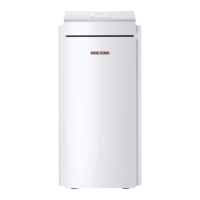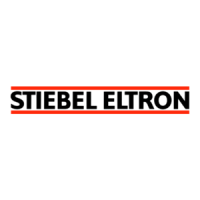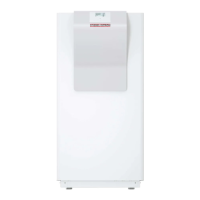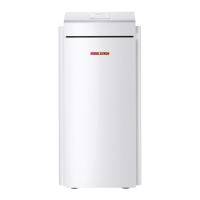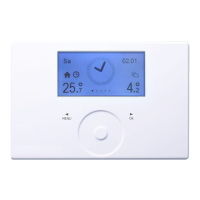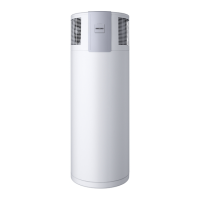| 11
9.5.2 T-support SK1
Note
Install a ribbon heater when mounting on the wall
bracket or T-support (see chapter "Electrical connec-
tion/ Ribbon heater").
A
B
8
5
7
3
4
2
1
6
9
10
D0000050006
A Depth of frost line
B 300
1 Heating flow
2 Heating return
3 Conduit for supply lines
4 Foundation
5 T-support
6 Gravel bed
7 Condensate drain conduit
8 Condensate drain
9 Ribbon heater
10 Cover
Observe the structural limits of the T-support used.
See the dimensioned connection drawing for the correct
spacing between holes (see chapter "Specification/ Dimen-
sions and connections").
9.5.3 WK 2 wall mounting bracket
Note
Install a ribbon heater when mounting on the wall
bracket or T-support (see chapter "Electrical connec-
tion/ Ribbon heater").
Note
To prevent disturbance due to structure-borne noise
transmission, never install the wall mounting bracket on
the external walls of living areas or bedrooms.
Install the wall mounting bracket on a garage wall,
for example.
≥300
2
3
6
4
D0000058719
1 Heating flow
2 Heating return
3 Condensate drain
4 Ribbon heater
5 Condensate drain conduit
6 Wall mounting bracket
Observe the structural limits of the wall mounting bracket
used.
See the dimensioned connection drawing for the correct
spacing between holes (see chapter "Specification/ Dimen-
sions and connections").
9.6 WPM heat pump manager
A WPM heat pump manager is required to operate the appliance.
This controls the entire heating system.
Observe the WPM installation instructions during installation.
9.7 Buffer cylinder
!
Material losses
A buffer cylinder with diffusion-proof insulation is es-
sential to enable cooling by means of fan convectors. The
emergency/booster heater must be connected.
Note
If cooling is provided via an area heating system, the
buffer cylinder is not required.
We recommend the use of a buffer cylinder to ensure trouble-free
appliance operation.
The buffer cylinder provides hydraulic separation of the volume
flows in the heat pump circuit and heating circuit, and also serves
as an energy source for defrosting.
For operation without a buffer cylinder, observe the details
in chapter "Minimum flow rate with individual room control
via remote control in systems without buffer cylinder".

